
Friday February 17, 2006
NINCO Classic Austin Healey
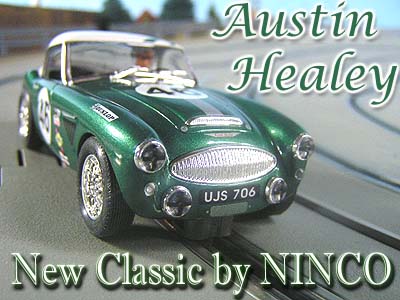 Back in 2002, NINCO released a new model in the Classic
line of the Austin Healey MkIII. Since then there have been several additions
but it has been quite some time since we have seen a new release. Arriving here
safe and sound from MRC, this new Classic was a welcome sight and I looked
forward in putting this little gem through its paces.
Back in 2002, NINCO released a new model in the Classic
line of the Austin Healey MkIII. Since then there have been several additions
but it has been quite some time since we have seen a new release. Arriving here
safe and sound from MRC, this new Classic was a welcome sight and I looked
forward in putting this little gem through its paces.
What impressed me the most when I first seen this model was the overall fit and finish. NINCO has really made this car into an eye-catching livery with a finish and clear-coat that was near perfect on our sample. The body shape seems a little on the short side and perhaps could sit a little lower, but overall NINCO has still done well in our scale.
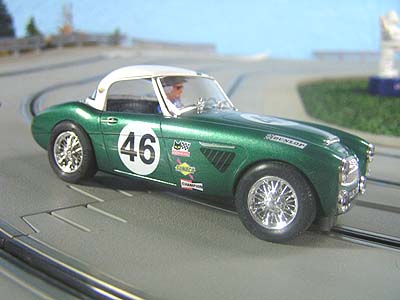
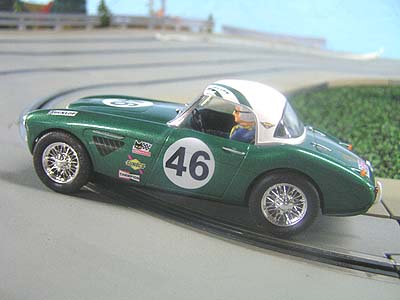
Overall I like the fact this model is adorned with some type of numbering to give it more race appeal than previous street versions. Detail level is more than enough to suit my tastes and I like the fact NINCO stays with this simple, but effective approach. The driver looks right at home behind the wheel and the half-try interior has a good amount of scale appeal in my eyes. Considering the amount of room this small car has over the large motor, this is about as much interior as you could ask for.
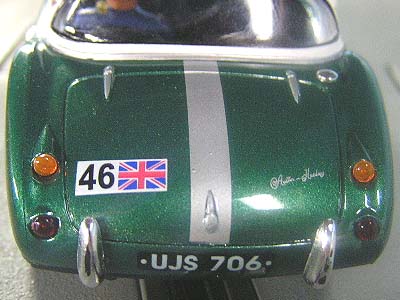
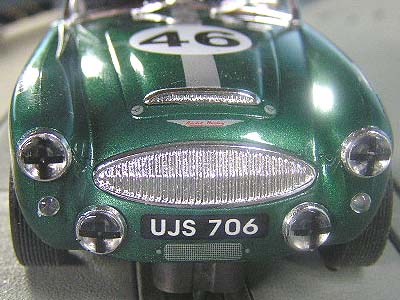
Wheels and tires here are standard NINCO and were very round and true. The standard NINCO rubber does need a little sanding to get things the way I like them, but out of the box it performed well enough. After-market silicone tires have long been a favorite among many racers for NINCO classics, but for now I'll keep the original rubber.
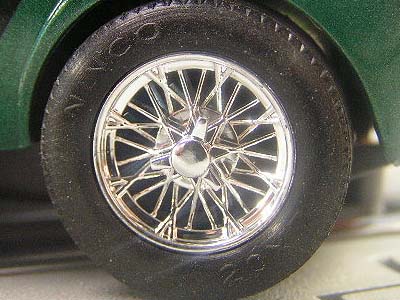
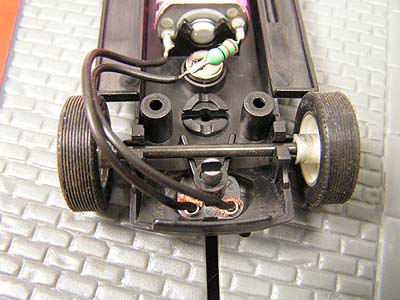
One thing I did notice about this model during the initial test was the side-to-side free-play of the front axle, or lack of it. Prior releases of NINCO models has seen a rather excessive amount of this free-play, but on this model it has all but vanished. There is of course still a slight amount here, but not even enough to warrant any modifications. I am happy to see this and I hope NINCO applies this in other future models.
Looking underneath we see the NC-5 20,000 RPM motor sitting in the inline position along with the standard NINCO button magnet just forward of it. 4 screws mount the body to the chassis and they were quickly removed to get inside for a closer look.
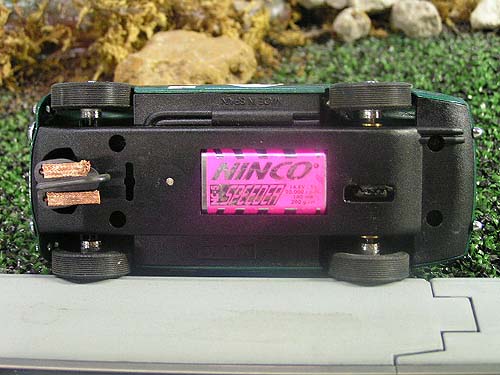
The NC-5 is equipped with a 9 tooth brass pinion that turns the 27 tooth crown gear. The real axle is set in place with brass bushings and the bushing to chassis fit was very snug. Although I found no spinning of the bushings under load, I still added a light amount of hot glue across the tops of them as a preventive maintenance measure.
One thing I did find while testing the model without the body was the motor flex. Under load, the motor would rock in the chassis mount and quite easily too. No real issue, a simply drop of glue across it and this stopped the problem easily.
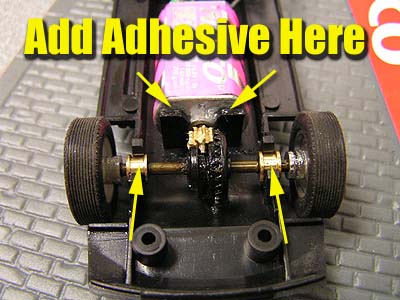
If there is anything to really complain about, it is the motor they chose to put into this small classic.. The NC-5 is a good little motor, but in such a small car with this light amount of magnet, it can make the car hard to control on small to medium sized layouts. On longer straights or on layouts that have broader radius turns this motor will most likely please most in our hobby. On our modest 4 x 16 foot 4 lane layout it was a handful, and this was with PARMA 35 ohm control and a voltage setting on our Pyramid PS26KX adjustable supply of 12 volts.
On standard NINCO power with the 55 PLUS ohm controllers, the control was even less. This however is mostly due to our small, tighter layout. If you have a larger layout in your home, then you should find the extra power in this model a welcome addition. Keep in mind that everyone has different tastes when it comes to motors, control and power. Some have no problems taming hotter models while others struggle with them. I mention this only for those home racers who do not have large layouts and who might find this model a little over-powered.
A New Test
Recently, our testing facility was improved with the addition of a routed wood track. Now we can finally take these models and test them in a broader spectrum and pass the results on to you. One important item to mention is that these ready to run models are not designed for wood track use. Hence, if they do not perform perfectly in this situation it is not really a bad mark against them. This new test I feel is important as our hobby is growing rapidly and wood tracks have seen a huge following in the last few years.
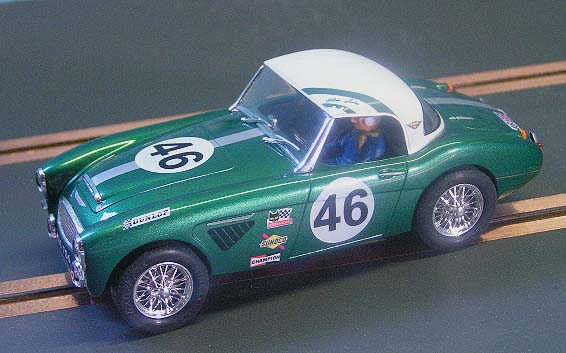
Have you ever driven a slot car and after the first few laps find yourself smiling and maybe even laughing out loud? I have and this model certainly made me repeat history. The smooth action and sliding this model had was a joy to pilot around our small oval. There was a slight "chop" or wheel hop to it but nothing too offensive. I decided to take the car back to the workbench and see if I could smooth it out a little more.
Closer inspection of the rear wheels and tires was first. Some enthusiasts seem to disregard any plastic wheel and advise people to invest in after-market aluminum replacements. As much as these types of wheels can help, a little time spent with your standard wheel can pay huge dividends. I found that our wheels had the same issues as many before it: Excess flash molding and burrs on the wheel inner and outer ribs.
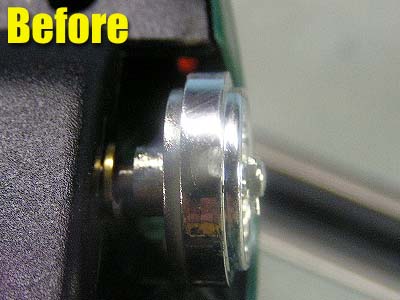
Using the techniques we describe here, these wheels were cleaned up quickly and it was time for more tire sanding. After this was completed, it was time to head back to the track and see what improvements, if any, we have made.
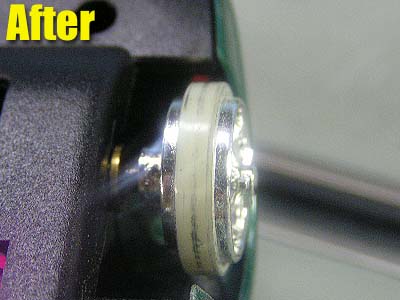
Well, this small amount of effort was worth the time. This model was now incredibly smooth and even easier to drive. Acceleration and braking were crisp enough for most any driver and performance down the straights showed no signs of "chop" from the rear. A smooth little performer even without added weight.
I have not added weight yet as without a lap timer installed, it would be difficult to report our findings. Given the way the car drives now, I'll keep it as is. It is plenty of fun for the time being but I am sure in the future we will come back and find the right set up to give us the best lap times possible.
Verdict?
The only thing missing from this car is 3 more to go with it. If I had a magic wand, I would wave it over NINCO and make others using a similar livery only in 3 different colors. This model is FUN and offers a challenge not seen in the heavier magnet cars that seem to frequent our hobby. Although I still feel it is over-powered, it still can offer a great deal of fun to your current racing stable.
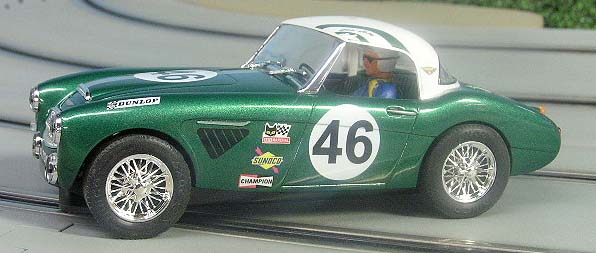
Old Classics like this are some of my favorites. They can sometimes be a handful to tame, but a good challenge in tuning a slot car is sometimes half the fun. I think anyone in this hobby should look closely at adding at least one of them to experience what they have to offer. If another version follows, I can easily say it will join my collection.
- Harry
As always feel free to contact me about this article or just the hobby in general at harry@homeracingworld.com, or better yet drop into our Message Forum and share your thoughts with other enthusiasts!
Thanks Go To MRC For Providing Us With This Sample